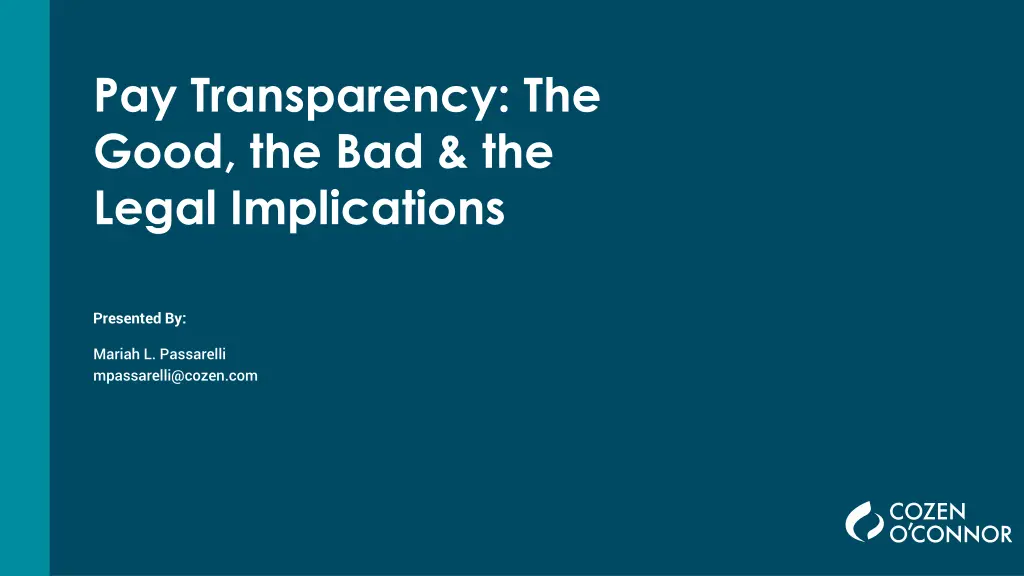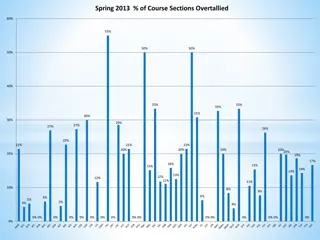
Understanding Pay Transparency: The Legal Framework Explained
Explore the nuances of pay transparency in the workplace, covering topics such as pay equity, federal laws like the Equal Pay Act of 1963, and related legislation. Gain insights into the implications and requirements for employers regarding fair compensation practices.
Download Presentation

Please find below an Image/Link to download the presentation.
The content on the website is provided AS IS for your information and personal use only. It may not be sold, licensed, or shared on other websites without obtaining consent from the author. If you encounter any issues during the download, it is possible that the publisher has removed the file from their server.
You are allowed to download the files provided on this website for personal or commercial use, subject to the condition that they are used lawfully. All files are the property of their respective owners.
The content on the website is provided AS IS for your information and personal use only. It may not be sold, licensed, or shared on other websites without obtaining consent from the author.
E N D
Presentation Transcript
Pay Transparency: The Good, the Bad & the Legal Implications Presented By: Mariah L. Passarelli mpassarelli@cozen.com
Pay Equity vs. Pay Transparency Equity The concept of compensating employees who have similar job functions with comparably equal pay, regardless of their gender, race, ethnicity, or other legally protected status. Transparency The practice of openly displaying employee salary information to existing employees and candidates.
What is old is new again Pay Equity laws have long existed at both the federal and state levels (with the federal Equal Pay Act ( EPA ) having passed into law in 1963) Expansion/revision of the concepts within the EPA has occurred in many states over the past several decades Pay Transparency is the comparatively new frontier, but is really based upon the same core concept employees and job candidates should know that they are being paid equitably
Federal Law: The Equal Pay Act of 1963 Equal Pay for Equal Work: prohibits employers from paying different wages to men and women who work in jobs that require substantially equal skills, effort, and responsibility and are performed under similar working conditions within the same establishment. Equal" work does not mean identical jobs; rather, the jobs must be "substantially equal" in overall job content, even if the position titles are different. Establishment is a distinct physical place of business rather than an entire business or enterprise consisting of several places of business. Four affirmative defenses: (1) seniority system, (2) merit system, (3) a system that measures earnings by quantity or by quality of production, or (4) any factor other than sex. No exhaustion of administrative remedies.
Other Federal Laws Since passing the EPA, Congress has expanded federal protection against compensation discrimination through a variety of additional laws: Title VII of the Civil Rights Act of 1964 Age Discrimination in Employment Act of 1967 Section 501 of the Rehabilitation Act of 1973 Lily Ledbetter Fair Pay Act of 2009: Each paycheck that contains discriminatory compensation is a separate violation regardless of when the discrimination began. Overturned the Supreme Court's decision in Ledbetter v. Goodyear Tire & Rubber Co., Inc., 550 U.S. 618 (2007), which severely restricted the time period for filing complaints of employment discrimination concerning compensation.
State Law: Pay Transparency So far, eight (8) states have pay transparency laws on the books: California Colorado Connecticut Maryland New York Nevada Rhode Island Washington
Challenges With a lack of uniformity and widely varying requirements from state-to- state (as well as based on local/municipal laws) complying with pay transparency requirements is a growing challenge for employers Many of these laws impose requirements for job postings if the candidate in question can work (including remotely) from the state
California Effective: January 1, 2023 Applies to: Employers with 15 or more employees, with at least 1 working in California Requires: Employers must (1) disclose salary range in all job postings, including for jobs that can be done remotely from the state, and (2) disclose position s salary range to current employees upon request
Colorado Effective: January 1, 2021 Applies to: Employers with at least 1 employee working in Colorado Requires: Employers must disclose in all job postings, including for jobs that can be done remotely from the state (1) a salary range, (2) a general description of any bonuses, commissions, or other forms of compensation, and (3) a general description of all benefits
Connecticut Effective: October 1, 2021 Applies to: Employers with at least 1 employee working in Connecticut Requires: Employers must provide wage range information to an applicant upon the earliest of (1) the applicant s request, or (2) prior to or at the time the applicant is made an offer of compensation. Also requires that employers provide an employee the wage range for the employee s position upon hiring, a change in position, or upon the employee s request.
Maryland Effective: October 1, 2020 Applies to: Any employer engaged in business in the state of Maryland Requires: Employers must provide the wage range to applicants upon request.
Nevada Effective: October 1, 2021 Applies to: Any employer in Nevada Requires: Employers must (1) provide applicants who have completed an interview for a position the wage or salary range or rate for the position, (2) provide the wage or salary range or rate for a promotion or transfer to a new position if an employee has (a) applied for the promotion/transfer, (b) completed an interview for the promotion/transfer or been offered the promotion/transfer, or (c) requested the wage or salary range or rate for the promotion/transfer.
New York State Effective: September 17, 2023 Applies to: Employers with 4 or more employees Requirements: Employers must (1) disclose the compensation or a range of compensation in any job advertisement, as well as in the context of any promotion or transfer opportunity, and (2) provide the job description for such job, promotion, or transfer opportunity, if such a description exists
New York City Effective: November 1, 2022 Applies to: Employers with 4 or more employees, with at least one employee in NYC Requires: Employers must (1) disclose a minimum and maximum annual salary or hourly wage in any advertisement for a job role that will or may be filled in NYC, including for jobs that can be done in the field or remotely from the city, and (2) disclose a minimum and maximum salary range in any posting for internal promotions or transfer opportunities
Rhode Island Effective: January 1, 2023 Applies to: Rhode Island employers with 1 or more employees in the state Requires: Employers must disclose (1) the wage range upon applicant s request and prior to discussing compensation, (2) the wage range for the employee s position, both at the time of hire and when the employee moves into a new position, and (3) the wage range during the course of employment, upon request by an employee
Washington Effective: January 1, 2023 Applies to: Employers with 15 or more employees, if they have 1 or more Washington-based employees or if they engage in business in Washington or recruit for jobs that could be filled by a Washington- based employee, including remote jobs Requires: Employers must disclose (1) the wage scale or salary range and a general description of all the benefits and other compensation in each posting, including for jobs that can be done remotely from the state, and (2) the wage scale or salary range for the employee s new position, upon request of an employee offered an internal transfer to a new position or promotion.
Cincinnati and Toledo, Ohio Effective: March 13 and June 25, 2020, respectively Applies to: Employers with more than 15 employees in Cincinnati/Toledo Requires: Employers must provide a salary range upon a candidate s request after conditional offer of employment is made
Pennsylvania Pay Transparency? On March 13, 2023, the General Assembly of Pennsylvania proposed HB356. If passed: Will apply to: Employers with 15 or more employees (unclear whether these individuals must be working in PA) Requires: Employers must (1) include salary range in all job postings, (2) provide current employees with the salary range for their current role, as well as for jobs within the employer s business that are substantially similar to the skill, effort, and responsibility required to perform their job.
West Virginia? Proposed Pay Transparency legislation was briefly considered in West Virginia, but did not pass. Keep an eye out for this to be reintroduced in future sessions.
Benefits of Pay Transparency The impact of pay transparency policies on employees and employers has not yet been adequately studied. Theoretically, pay transparency should increase employee satisfaction because employees generally value clear and open communication with their employers. To be sure, however, this will only be true if employees like what they see! Pay Transparency could also be a very helpful tool in assisting (read: motivating) employers to close unlawful pay gaps
Drawbacks of Pay Transparency Transparent pay may make it more difficult for employers to attract and retain talent in an already tight job market Pay transparency could pit employees against each other Pay differences may be taken out of context by employees If unlawful pay practices are revealed through pay transparency (particularly for existing employees), EPA and Title VII litigation may follow
EEOC Charge Data Source: The Continuing Impact of Pay Discrimination in the United States. Office of Enterprise Data and Analytics (OEDA) Data Highlight No. 1. U.S. Equal Employment Opportunity Commission (EEOC), Washington, DC, March 2022.
EEOC Charge Data (contd) Source: The Continuing Impact of Pay Discrimination in the United States. Office of Enterprise Data and Analytics (OEDA) Data Highlight No. 1. U.S. Equal Employment Opportunity Commission (EEOC), Washington, DC, March 2022.
What can you do? Determine whether your company is operating in a state or municipality with a pay transparency law. Be sure to consider whether you are advertising positions that may be filled by individuals who will be working from these locations. Create a check-list of disclosure requirements and review each job posting (including, if applicable, promotion/transfer posting) for compliance. Establish a method of clear reporting and communication with employees in jurisdictions where this information must be provided to existing employees. Enlist the help of legal counsel if you are unsure of how to proceed.






















